In today’s AP environment, the phrase “exception workflow” refers to any invoice or payment transaction that deviates from standard straight‑through processing. In a manual setting, exceptions cause delays, cost overruns and risk. In an automation‑centric setting, exceptions are flagged, routed and resolved efficiently, enabling finance leaders to shift focus from firefighting to strategy.
The Problem: Manual Exception Workflows
Manual exception resolution workflows in AP typically involve:
- Invoices arriving via paper, email or multiple channels, requiring manual data entry.
- Invoice‑to‑PO mismatches, missing approvals, duplicate invoices or unregistered vendors.
- Chasing down approvers via email/phone, ad‑hoc routing, spreadsheets tracking status.
- Limited visibility into “where is that invoice?” and limited metrics on exception volumes.
Manual exception resolution drains resources, reduces scalability, and occupies valuable finance bandwidth.
Automated Exception Resolution Workflows: What They Look Like
An automated exception‑resolution workflow for AP typically includes:
- Invoice capture technology (OCR/IDP) ingesting invoices electronically and extracting key fields.
- Automated matching logic (2‑way/3‑way match) comparing invoice to PO/receipt and flagging mismatches.
- Business‑rule engine to route flagged exceptions to the right approver, with reminders and auto‑escalation.
- Dashboards and analytics to monitor exception rates, cycle times, bottlenecks and resolution metrics.
- Continuous improvement loop: system learns from repeated exception trends (e.g., vendor always missing PO number) and builds predictive logic.
When implemented effectively, the exception workflow becomes a controlled, measurable process rather than an ad‑hoc bottleneck.
Strategic Implications for Finance Teams
- Shift AP from cost centre to strategic enabler: By reducing time spent on exceptions, AP teams can focus on vendor relationships, cash‑flow optimization and analytics.
- Improve vendor satisfaction and capture early‑payment discounts: Faster resolution of exceptions means fewer payment delays, better terms, stronger vendor partnerships.
- Strengthen internal controls & audit readiness: Automated exception workflows embed controls, preserve audit trails and reduce risk of regulatory or internal‑control failures.
- Prepare for growth without linear cost increases: For companies scaling operations, automated exception workflows enable AP volume growth with less incremental cost.
- Enable data‑driven decision‑making: With dashboards on exception types, resolution times, root‑cause analysis, finance leaders can proactively reduce exception volume and improve process design.
Real Data: Manual vs Automated

AP teams report 60 - 80% lower processing costs after automation.
Exceptions in accounts payable aren’t simply “annoying”; they represent hidden cost, risk and inefficiency. Manually managing exception resolution workflows is no longer viable for mid‑market firms facing volume growth, margin pressure and tighter controls.
On the other hand, automating exception workflows converts “fire‑fighting” into “streamlining”, enabling finance teams to deliver speed, accuracy and control. The data supports significant reductions in cost, cycle time, risk and resource consumption.
Book a demo to see how Finofo automates exception workflows and unlocks working capital.







